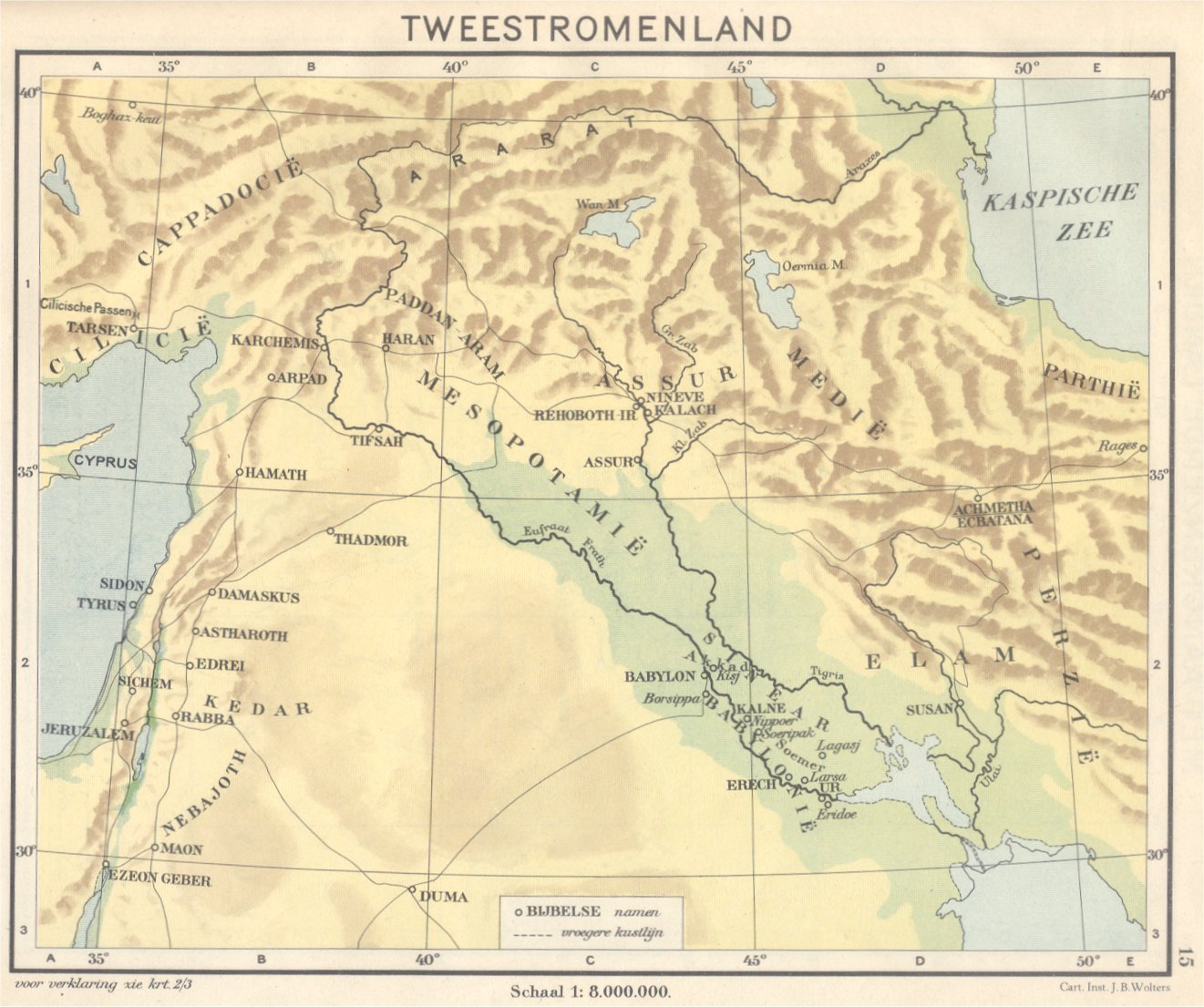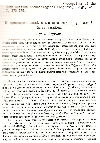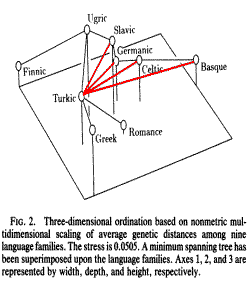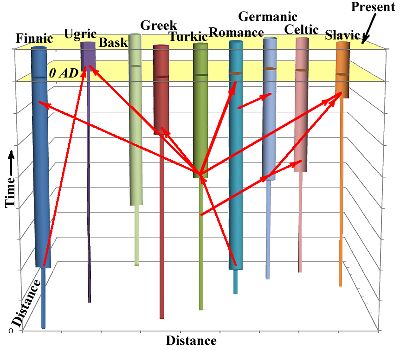Sumerian or Sumer language is the most ancient cultured language of the world. About
a thousand years before Christ it no longer existed, but the news about it in its literature, consisting of
cuneiform writing, dates back to over 4,500 BC. During the 3500 years of its existence, the language from
the first start when Sumerians invented their
writing system gradually evolved and reached a considerable height of which we received news only through
studies and reading cuneiform inscriptions on rocks in the ruins of Babylon and other neighboring
cities. Homeland of the Sumerians was in the Sinear land, namely
in the area of the rivers Euphrates and Tigris. Sumer language was divided in two vernaculars,
the Sumer proper in the south and the northern (Semitic) Akkadian in the northern part. The southern dialect was cleaner than the northern, but both comprised one Sumer language (Yeah,
Walloon and Flemish also comprise a single Belgian language).
Sinear land

Then a question became interesting, which tribe the Sumer people belonged to according to
its language. The French scientist Oppert and an English expert on cuneiform writing Rawlinson were of the opinion that the
Sumer language by origin belongs to the Ural-Altaic languages. They were joined by Finnish scientist Yrjo Koskinen. Then a
French scientist Lenormant, a great connoisseur of the cuneiform writing, was of the same
opinion that exactly Sumerians, according to their language, were the people of the Ural-Altaic,
or more precisely even Ugro-Fennic origin. He was joined by English scientists Smith and Sayce, well engaged in reading
of the cuneiform writing and Ugric-Altaic languages.
They were followed by German scientists Onken and Hommel and a large number of other
German and French researchers.
But against this affinity of the Ugric-Altaic languages
with Sumerian language argued few scientists, and mainly three, namely French scientist Halevy, a
German expert on Sumer language Paul Haupt and a docent of Sanskrit language Helsingfors
(Helsinki) Donner. But
it should be stated that Halevy and Haupt barely or not at all studied the Finno-Ugric languages,
and Donner, who has written several good works on the Finno-Ugric comparative linguistics, I think
deliberately ignores many akin /448/ motifs and elements. Of the other opponents of the
Sumer language affinity with the Ugric-Altaic I do not want to talk, because due to their ignorance of the Finno-Ugric
languages, they are irrelevant. The best experts in the Finno-Ugric languages are Finnish scientists Castrén and Ahlqvist had no occasion to express their opinion against or in favor, but the nature of their philological studies can rank them with the first group, in favor of affinity of the Sumer language with the Finno-Ugric languages.
Let us turn now to the comparison of the languages under consideration.
To establish an affinity of one language with another or others, we
should find similar, alike, or identical forms 1) in phonetics, 2) in etymology, 3) in lexicography,
and 4) in syntax — in all compared languages.
In respect to the phonetics of the Sumer language
should be stated that the whole of its sound structure has a simple,
transparent nature unique for the all Ugro-Altaic languages. The property of the language is such
that every word in the beginning has only one consonant sound - following most of the Ugric-Altaic
languages, that avoid complex sounds ch, sch, ts, etc. at the beginning of the words. In the middle of
the words a consonant follows a vowel and vowel follows a consonant as in the Finno-Ugric languages, and
the diphthongs or complex consonants are few. For the most part the words
only have one syllable, rarely two, very rare three syllables.
One of the main centerpieces of the Ugric-Altaic languages is the so-called vocal harmony
(vowel harmony) or similarity of the vowel sounds within one
non-complex word. This important grammatical law classifies that vowels
are divided into three parts: 1) hard a, o, u, 2) soft ä, ö, ü, and ə, and neutral (middle) e, i.
This law of vocal harmony - although the language evidently has other sounds for the words - in
fact comprises the same phonetic phenomenon that we find in the above Ugric-Altaic languages, and just for that reason
every expert should attribute Sumer language to the Ugric-Altaic group. In particular, so has done the French
researcher Lenormant, for which he had a full right to do. This aspect must be a most dicisive when
we know that the law of vocal harmony exists only in the Ugric-Altaic languages, and it is totally
absent in the European-Aryan languages.
In respect to the etymology, first should be noted that
the Sumer language does not have grammatical gender of the words, i.e. it does not have words of male and female and neutral gender,
as e.g. have almost all languages of the European-Aryan origin. Like all Semitic languages, the ancient Assyrian language had
words of male and female gender, therefore it very much differed from the Sumer
language, from which it borrowed many words. As is known, all languages of the Ugric-Altaiic
peoples without exceptions have no words with grammatical gender. In that is one of the main traits
of their affinity with each other, as well as with the Sumerian language. All languages of the
Ugric-Altaic peoples, like the Sumerian, denote the natural male and female sex with special individual
words that grammar-wise do not carry in themselves neither male, nor female, nor neutral gender.
As to the individual words, it should be stated that the lexical-graphical side of the Sumer language
has not been enough studied and processed. We just do not know all Sumerian words comprising the vast literature of
the cuneiform rock writing in the ruins of the oriental cities. It is possible to hope that their
quantity will increase in the future. But a number of those words which /449/ so far became known,
and which comprise the read Sumerian texts, correspond in substance and meaning to the similar words
in the Ugric-Altaic languages. The number is not very large, but related to the number of the total
known lexical stock, it is sufficient for comparison. It constitutes lexicographical material for
lexicographical comparison of the Sumer language with other Ugric-Altaic languages.
In the following presentation I will cite a few words:
In Sumerian ad or adda “father”, in
Median atu, adda, in Est (Estonian) att, ata or ätt, in
Finnish ati “father-in-law”, in Magyar atya “father”. in Ostyak ata, in Vogul
aze , in Votyak ataj, in Mordovian ata “old man”, in Cheremis
(Mari) aĉі, ati, ata. Apparently, this root has also passed to the Aryan-European languages, for example in Greek ά: τα, in Russian ot- ets. Sumerians also had
a God Atar, “father” of the light.
In Sumerian nene “woman, virgin”, in
Est (Estonian) neid, neiu, neitji “maiden” in Finnish
neito, neiti, neitsyt, in Lapar (Sami, Lapp) nieid, neit, neita, in Magyar ne,
in Manchur neinei, in Chinese niu, in Zyryan nil. From the same root comes the Finnish nainen “wife”, in Votyak
and Veps naine, in Est (Estonian)
naene or naine, in Livonian nai, in Magyar nö.
(English nanny, nana; French norrice; Latin nutricius “wet-nurse”; Greek nanna “aunt”. “Nutrition” and
“nurse” also are derivatives of a form of nanny. All “IE” forms are spotty and without credible
etymology).
In Sumerian an “sky”, anna, annab “God, Goddess” or “father, mother”,
in Median annap, in Turkish and Tatar ana “mother”, in Magyar anya “mother”, in Votyak
ana, anaі, in Ostyak angi, in Lapp (Sami) aedne, in Votyak ene, in Tungus änä “mother”, in Est (Estonian) (Fellin
dialect) änn “mother”.
In Sumerian akku “big”, in Median ukku, in Finnish ukko “grandpa, old man”, and a
mythological deity, in Est (Estonian) ukku, uku, in Veps uk
(Türkic aga “senior, elder”became a true international word in the Eurasia).
In Sum. tur “son, baby”, and also “boss, chief”, in Median tar, in Est (Estonian)
(Verro vernacular) tsura “young man”, in Magyar gyermck “baby”, in Mordvinian tsur “son”, in Turkish (eastern
vernacular) tura “royal court, chief”. (English tower with numerous
cognates in "IE" languages and numerous derivatives, all forms are spotty and without credible
etymology; in addition English has a synonymic “castle” from the same source and with dubious “IE”
etymology. Russian also has “tura” as tower).
In Sum. erim, eriv, eri “slave, servant”, in Est (Estonian)
orі, in Finnish orja, in Livonian verg. Another form of the Sumer word
“servant” eru, uru, ur, in the Magyar ur “lord”. According to Yrjö-Koskinen, the
Aryan-European root is in Sanskrit ayrja, in Germ. Ehre, in French air of the
same origin. The Magyar word ur is found in in Finnish lang. uros, in Zyr. veres or
verös, and in the Lithuanian vyras, in
Latvian virs, and in Latin vіr. According to Koskinen, Sumerians were taking Aryans as servants,
and thus so different concepts converge in one word.
To cite Yrjö-Koskinen tongue-in-cheek idea of Finns employing Arians as servants
is hilarious, he clowned the self-admiring “Aryan” spirit of his days. Closer to home is the example
of the guest vs host, both derivatives of the Türkic göster (n., v., adj., adv.), stem
of göstermek = to demonstrate, which developed and was borrowed with bifurcated
semantics natural for agglutinative languages but alien for the receiver languages. With
agglutinated affixes, the stem produces both active and passive verbs, nouns, and adjectives, akin
to “demonstrator” and “demonstrated”. The Türkic ar/er/ir “man”, like Sumerian er,
and like göster, can produce active and passive semantics, creating bifurcated meanings. That
bifurcated meaning is retained in English, e.g. “he is the man” means that he is a hub point, a
chief, and “my man does it” means that he is a subordinate. This bifurcation can be expanded to any
situation: “boss”, “enlisted troops”, “serfs”, etc.
Since, unbeknown to Yrjö-Koskinen and
his cohorts, the Indo-Iranian “Aryans” migrated to the Iranian Plateau and Indian subcontinent at
about 1500 BC, Sumerians did not have a chance to employ the “Aryan” men in either master, nor a
servant capacity. The etymology comes from a different time, different language, and different life. |
In Sum., in Akkadian gu or ge “night”, in Fin. yö, in Est
(Estonian) öö, in Mordvinian ѵe, in Cheremis
(Mari) jut,
in Votyak üі, in Zyryan ѵoі, in Lapar (Sami, Lapp)
igja, in Ostyak at, in Vogul i and edi, in Magyar ej,
ejszaka (ejsaka), in Turkish gedsche.
In Sum. ar “country of the world”, in Magyar or-szag (or-sag) “country, land”,
in Est (Estonian) kaar, in Finnish. kaari.
Some Sumer language words can be found common with other languages, for example in
Sum. gala “great” in Est (Estonian) Kole “scary, huge”
(Türkic Ogur gulu, Oguz ulu/ulug); in Sum. sagig
“crazy” in Ostyak jōgedus, by Fin. jokeus (Türkic qal); in Sum. kal “hearty, touched”, in Estonian hale; Sum. jaga or sada, in Ostyak suda, in Finnish jydan
(Türkic köŋül/küŋül/kögül, köŋüldaki/köŋültäk); in Sum. іla “through”, in Est
(Estonian) ule (Türkic üzä); in Sum. meni “поди”
(?), in
Estonian mine; in Sum. ena or enu “master”, in Est (Estonian) onu
“uncle” (meaning “guest, master” “kula, onu”) (Türkic idä/idi);
dingir “god”, in Turkish tengri; in Sum. nzu “meat”
(an apparent typo, in lieu of “uzu”), in Magyar hus; in Sum. til
“full”, in Magyar tele (Türkic tolï/tolu); in Sum.
pal “sword”, in Magyar pallos; in Sum. mar /450/ “road”, in Magyar mor; in Sum. ar
“nose ”, in Magyar orr; in Sum. nab “light ”, in Magyar nap “day”,
in Sum. sal “vulva”, in Magyar szül (sül) “give birth”, in Sum. ud “sun”, in Mongolian ud;
in Sum. e “house”, in Turkish eѵ; in Sum. gallies “expensive”, in Est (Estonian) and Fin. kallis.
The Sumer language personal pronouns without a doubt have the same basis that exist in almost
all the Ugric-Altaic languages. But the same foundation or elements are also found in the European-Aryan languages, and therefore some scholars like Halevy and Donner, argue that
these elements are not only Ugric-Altaic and can't not serve as proof of the affinity between the
Sumerian and Ugric-Altaic language. It is undeniable that in fact in some Aryan-European languages are
pronouns of such elements. But this is not an evidence against the affinity of the Sumer
language with the Ugric-Altaic. The Sumer language existed before all known languages as the
language of culture, it had an influence on the Aryan-European languages also, but it did remain the
Ugric-Altaic language. Its nature belongs to that kind. Therefore, its pronouns are closer to the Ugric-Altaic than
to the Aryan-European languages.
Even more than that simple comparison the affinity of the Sumer
language with the Ugric-Altaic is proven by the attachment method of the possessive suffixes to the roots of the nouns. This method is the same that for example exists in the Fennic and Magyar languages, although in the phonetic
composition the suffixes seem to be different. So for example in Sumerian adda-mu “my father”, in Finnish isa-ni, in
the Magyar atya-m (Türkic atta-m); in Sum. adda-su “your father”, in Finnish.
isa-si, in Magyar atya-d (Türkic atta-g); in Sum. adda-na “his father”,
in Finnish sa-nsa, in Magyar aty-ja (Türkic atta-i); no-Sum.
adda-me “our father”, in Finnish isa-mmo, in Magyar atya-nk (Türkic atta-maz) and
so on. This method of connecting possessive suffixes, and the corresponding possessive suffixes, does not exist in the
Aryan-European languages, which confirms the view of Loporman, who has not completely noted this property.
Browsing through the forms of the numerals, we have to recognize that their resemblance is
striking. As is known, the names of the numerals play a major role in establishing affinity between languages.
We do not have sufficient material to compare syntax. The Sumerian compound
forms, for example, tursal, literally “child-daughter”, i.e., a maiden, in Est. (Estonian)
tutarlaps, in Manchurian sargan-jui; Sumerian si-me, literally “eyes water”, i.e., tears, in Est
(Estonian) silma-wesi, in Manchurian yasa-i-muke, etc. prove the certain the affinity of the Sumer language to the Ugric-Altaic languages.
In conclusion of all the observed materials for explanation of the relationship between the Sumerian
and the Ugric-Altaic languages, I am coming to the view that the Sumerian language is kindred with the Ugric-Altaic
languages, and that the Sumer people by their origin are close to the peoples of the Mongol-Fennic tribe.
We'd get even more evidence of this affinity when the cuneiform literature will be studied more thoroughly
on the vocabulary and forms. But even what we know so far is quite enough to have an affirmative opinion
on this affinity. The entire laws of language that correspond to the similar laws of other languages, can
not be accidental. The Ugric-Altaic languages, and especially the Finno-Ugric languages have a great-grandfather, or
at least an elder brother in the Sumer language.



